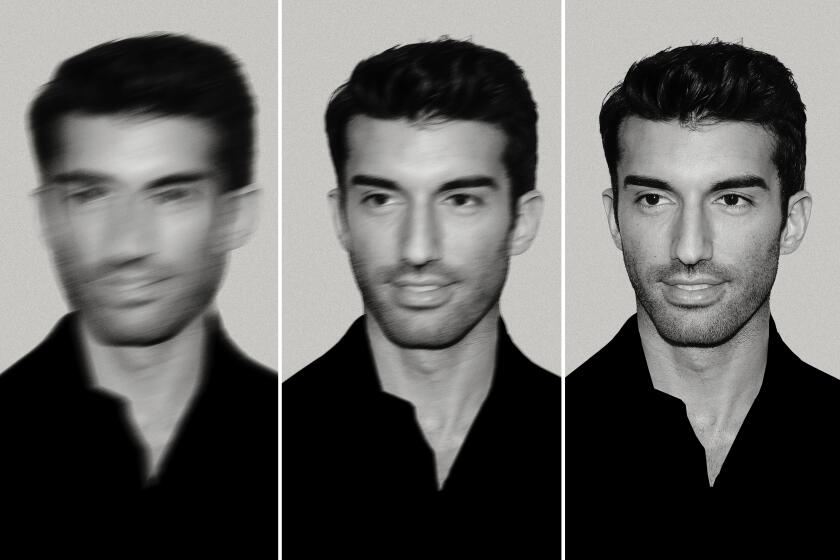Classic Hollywood: LACMA spotlights ‘20s German Expressionist films
- Share via
Complex. Sophisticated. Groundbreaking. Shocking.
These words describe the German Expressionist cinema during the Weimar era after World War I — a bravura brand of filmmaking that is still mesmerizing audiences and influencing filmmakers today.
They were highly stylized pictures with off-kilter set designs, innovative cinematography and chiaroscuro lighting that highlighted the nightmarish, dark and often perverse subject matters.
Among the master filmmakers were Robert Wiene (1920’s “The Cabinet of Dr. Caligari”), F.W. Murnau (1922’s “Nosferatu,” 1924’s “The Last Laugh”), Paul Leni (1924’s “Waxworks”) and Fritz Lang (1924’s “Die Nibelungen,” 1927’s “Metropolis”). And bringing their visions to the screen was the German studio Universum-Film AG, a.k.a. UFA, which dominated production and distribution there during this era.
A new exhibition, “Haunted Screens: German Cinema in the 1920s,” which opens Sunday and continues through April 26 at the Los Angeles County Museum of Art’s Art of the Americas building, explores this artistic epoch.
The post-World War I, pre-Nazi era in Germany saw a confluence of directors, producers, writers, costume and production designers and cinematographers craft motion pictures whose style helped create film noir and can still be felt in today’s horror and science fiction films.
The exhibition features 250 objects, including film clips, photographs, posters, documents and cameras representing 20 artists, 14 directors and 25 films.
“The core of the show is the collection from La Cinémathèque française,” said Britt Salvesen, LACMA’s curator of both the department of prints and drawings and the department of photography.
The 140 drawings from the Cinémathèque were acquired by noted German film historian Lotte Eisner, who wrote the 1952 book “The Haunted Screen.”
Two vintage “Dr. Caligari” production stills were culled from LACMA’s Robert Gore Rifkind Center for German Expressionist Studies, as well as “periodicals from that time period in which film is featured alongside other cultural endeavors,” said Salvesen.
Designed by USC architecture professor Amy Murphy and architect Michael Maltzan, “Haunted Screens” has been grouped by theme: “Madness and Magic,” “Myths and Legends,” “Cities and Streets” and “Machines and Murderers.” The latter contains a subsection, “Stairs,” that includes drawings from films that feature stairs as both a visual and psychological theme. Two darkened tunnels will feature excerpts from the movies highlighted in the exhibit.
“Haunted Screens” is the 10th LACMA exhibition in the last four years exploring the relationship between art and film. Previous exhibits have spotlighted filmmakers Stanley Kubrick and Tim Burton and cinematographer Gabriel Figueroa.
The Academy of Motion Pictures Arts and Sciences’ Margaret Herrick Library and Los Angeles-based private collectors also have provided objects for the exhibition.
“We have a number of three-sheet and six-sheet posters of such films as ‘The Blue Angel,’ ‘M’ and ‘Metropolis,’” said Ellen Harrington, director, exhibitions and collections, at the Academy Museum of Motion Pictures.
In conjunction with the museum show, the Academy@LACMA screening series will feature a German Expressionistic Cinema retrospective beginning Oct. 3 with the new 4K digital version of “The Cabinet of Dr. Caligari” as well as the 1962 remake.
German Expressionism, Harrington said, “was in many ways the maturing of the art house cinema in the late silent into the early sound era. They were starting to deal with more complex themes and stylistic decisions that made those films the precursor of what we’ve imagined to be art house cinema today. They stepped aside from the mass market kind of storytelling and starting delving into these more psychological and more human stories.”
These films also reflected the mood of Germany during the postwar Weimar period. Germans were reeling from the death and destruction of the four-year conflict, followed by the harsh reparations under the Treaty of Versailles. The country endured hyperinflation and other hardships that eventually led to the rise of Adolf Hitler.
Once the Nazis came to power in 1933, many of the architects of German Expressionism, such as Lang, came to Hollywood, where they put their stamp on genre cinema.
Also related to the “Haunted Screens” show are two exhibitions at the Skirball Cultural Center co-presented by the film academy. “Light & Noir: Exiles and Émigrés in Hollywood, 1933-1950” examines the role that émigré actors, directors, writer and composers played in the American film industry, and “The Noir Effect,” which looks at the influence of film noir on American pop culture, art and media. Both exhibitions open at the Skirball on Oct. 23 and continue through March 1.
------------
‘Haunted Screens: German Cinema in the 1920s’
Where: Los Angeles County Museum of Art, 5905 Wilshire Blvd.
When: 11 a.m.-5 p.m. Mondays, Tuesdays and Thursdays, 11 a.m. to 8 p.m. Fridays, and 10 a.m. to 7 p.m. Saturdays and Sundays, through April 26.
Price: General admission is $15; $10 seniors/students; free for children 17 and under and museum members.
Information: lacma.org
More to Read
Only good movies
Get the Indie Focus newsletter, Mark Olsen's weekly guide to the world of cinema.
You may occasionally receive promotional content from the Los Angeles Times.











